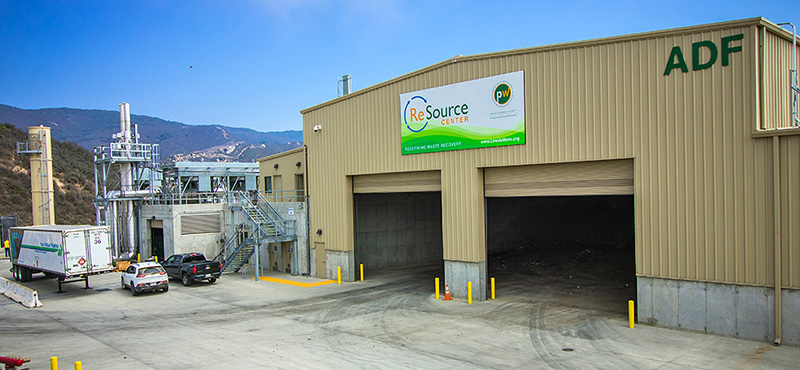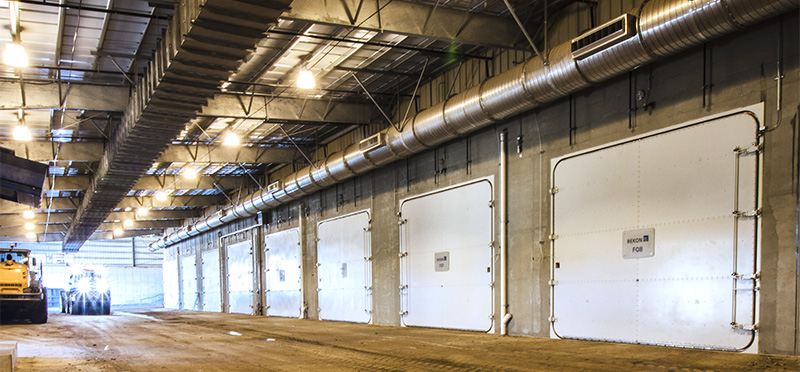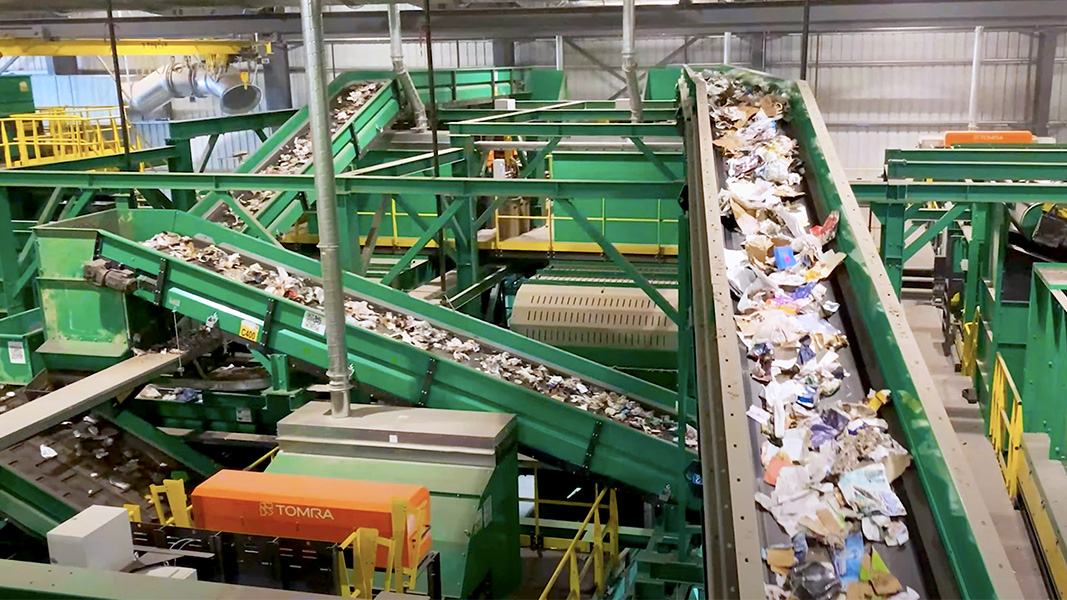Top: Incoming MSW is processed at the MRF to recover organic fines for the AD facility. Photo courtesy of Van Dyk Recycling Systems
Nora Goldstein
In 2009, the Santa Barbara County Department of Public Works issued a Request for Proposals (RFP) for a private developer to implement a resource recovery project at its Tajiguas Landfill in Goleta, California. The main project components in the RFP were a materials recovery facility (MRF) and an anaerobic digestion (AD) facility. The landfill receives waste from the South Coast and Santa Ynez Valley areas of the county, and the city of Santa Barbara — representing more than 250,000 of the county’s 450,000 residents. About 5% of all material received at the AD facility is source separated commercial organics from local hotels, restaurants, grocery stores, and the University of California, Santa Barbara.

Santa Barbara County’s AD facility. Photo by Lael Wageneck, Santa Barbara County Public Works Department
The RFP requested a mixed waste processing (dirty) MRF designed to sort up to 800 tons/day (tpd) of MSW into recyclables, organics and residue, and be able to recover up to 90,000 tons/year (tpy) of recyclable material. The adjacent AD facility (ADF) would have a design capacity to process up to 73,600 tpy utilizing a European dry fermentation technology. Feedstock would be comprised primarily of organic fines recovered from the MRF. The digestate would be composted in an area adjacent to the ADF.
Mustang Renewable Power Ventures (MRPV), LLC was awarded the project. The county owns the MRF and ADF and contracted MRPV to build and operate the facilities. Mustang operates the ADF and composting plants, and MarBorg Industries, a solid waste services provider that is the franchised hauler for the South County Areas, operates the MRF. The initial design included thermal gasification for the residuals stream, but the permitting process for that element was onerous and the gasifier was eliminated from the project.
Santa Barbara County named the recovery project The ReSource Center. The residential sector uses a three-stream sort: trash, including food scraps; single-stream recyclables; and green waste. Households do not put separated food scraps in the green waste cart. Commingling the organics in the trash, sorting them out at the MRF, and processing them via anaerobic digestion enables the southern portion of Santa Barbara County to comply with California’s organics recycling law (SB 1383). Jurisdictions in the North County areas have established commingled green waste and food waste collection programs. The county has a separate green waste recycling program that produces mulch used on avocado orchards in the region.
A BioCycle article in September 2021 highlighted the ADF’s opening. At the time, the composting facility was still under construction and began operating in November 2021. The MRF has capacity to process around 180,000 tons/year of trash and commingled recyclables and the ADF has a rated capacity of 80,000 tpy . Combined, the MRF and the ADF (with composting) cost about $135 million; the County received a $4 million grant from CalRecycle for construction of the ADF. MRPV selected a Bekon dry fermentation system — the first U.S. installation for Bekon, which is based in Germany. Bekon operated the ADF for 12 months (August 2021 to July 2022), at which point MRPV became the primary operator.
Processing Components
Mixed Waste MRF
MRPV sourced equipment for the MRF from Van Dyk Recycling Solutions. Incoming MSW (about 550-600 tpd) is processed during the MRF’s first shift; the second shift processes 150 to 250 tpd of single stream recyclables. The sortation system can accommodate 80 tons/hour of MSW and 30 tons/hour of recyclables. A shredder creates a 16-inch cut in the incoming bags of MSW, which then enter large trommels with 12-inch screens. The 12-inch minus fraction feeds into a 6-inch star screen, followed by a second 2.5-inch star screen. The 12-inch overs fall onto a manual quality control line where sorters pull out any recoverable cardboard, PET, metals, and aluminum commingled with the overs. The PET and aluminum have the primary commodity value. Organics in the residue from the mixed waste processing range from 10% to 15% by weight; of the organic fines going to the ADF, about 20% to 25% are inerts.
Anaerobic Digestion Facility
The ADF has 16 concrete tunnel bunkers and operates in a sequential batch process. Each bunker is 23-feet wide, 17-feet high, and 100-feet deep. About 250 to 300 tpd/day of organics are recovered at the MRF and brought to the ADF. Operators fill a tunnel to about 75% capacity with the daily organics delivery. Once loaded, the tunnels are closed and sealed air-tight. The material digests for 28 days. Percolate — a microbe-rich liquid — is periodically applied to the organic feedstock to keep it moist and inoculate it with the microbes that digest the organic feedstock and produce methane. The tunnels’ and percolate tank’s walls and floors are heated — using heat captured from the combined heat and power (CHP) engines — to maintain the percolate and tunnels at a temperature of 106° to 110°F. On average, about 50,000 gallons of percolate are used per fermenter.

The ADF has 16 tunnels that are filled and emptied using a front-end loader. Photo by Lael Wageneck, Santa Barbara County Public Works Department
MRPV notes that plastic and some 2.5-inch-plus inerts provide adequate porosity in the mass to facilitate percolate circulation. Moisture content of the material going into the tunnels is 45% to 50%. At the end of 28 days, operators remove 60% of the digestate in the garage. The remaining 40% is blended with incoming organic fines to inoculate the fresh material.
Composting
The moisture content of the digestate is 60% to 65%. The digestate is conveyed to the composting pad, where it is mixed in a 1:1 ratio (by weight) with an amendment. MRPV has experimented using ground green waste or mulch as the amendment versus finished compost and says they all work well in the mix.
The blended material is composted in windrows for 18 days and achieves PFRP within the required 15 consecutive days above 130°F. Typically, temperature of 131°F is achieved within 24 hours, and then remains in the 140° to 150°F range during active composting. Moisture content after 18 days is about 38% to 40%. The compost used as blending material sometimes undergoes a second 18-day composting cycle. Finished compost is screened in a trommel with 2-inch holes; the 2-inch-minus fraction is screened in a second trommel with 5/8th-inch holes. The unders are conveyed to a densimetric table to remove glass and stones. Residuals after compost screening are about 25% and are landfilled.
MRPV has been conducting trials with two types of aerated static pile composting systems — the GORE engineered cover and the Engineered Compost Systems’ ASP design — to control the odor emissions and increase the capacity of the compost facility. Ranchlands are among the markets being considered for the finished compost.
Biogas
The ADF has two 1.1 MW combined heat and power (CHP) engines, and the MRF has two 1.4 MW engines operating on landfill gas to power the MRF and ADF . There is also 1 MW of rooftop solar panels on the MRF and ADF. The ADF has a 20-year fixed-price contract power purchase agreement with Southern California Edison under the state’s feed-in tariff program (BioMAT) for small bioenergy renewable generators less than 5 MW in size.
About two years in, The ReSource Center is operating at or above expectations, according to MRPV. Receiving over 40 inches of rain in the beginning of 2023 (3 times the normal amount) resulted in excess percolate, which inhibited biogas generation. The ADF is slowly recovering from the setback, as the microbial levels in the percolate gradually increase and the composting facility gets back to normal operating conditions.













